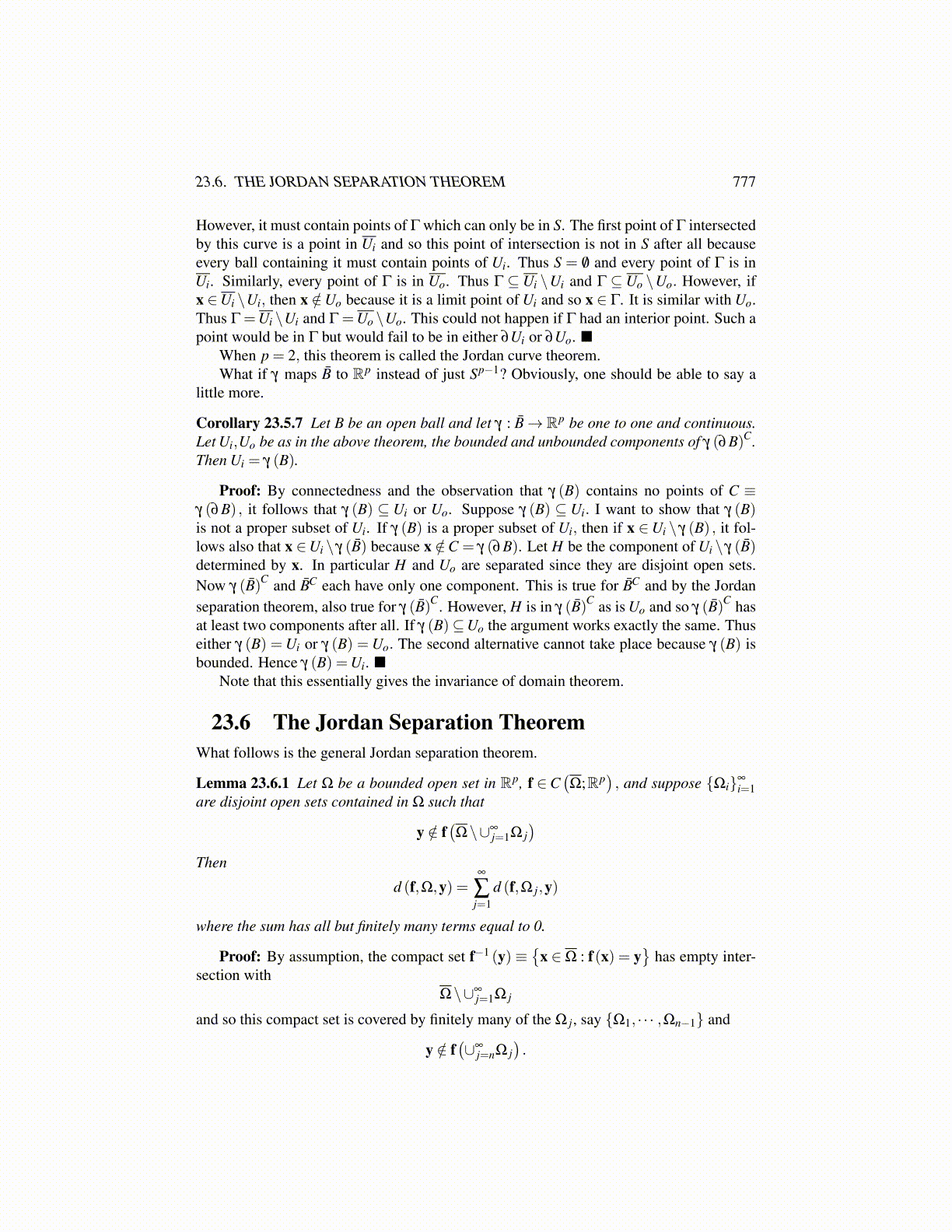
23.6. THE JORDAN SEPARATION THEOREM 777
However, it must contain points of Γ which can only be in S. The first point of Γ intersectedby this curve is a point in Ui and so this point of intersection is not in S after all becauseevery ball containing it must contain points of Ui. Thus S = /0 and every point of Γ is inUi. Similarly, every point of Γ is in Uo. Thus Γ ⊆Ui \Ui and Γ ⊆Uo \Uo. However, ifx ∈Ui \Ui, then x /∈Uo because it is a limit point of Ui and so x ∈ Γ. It is similar with Uo.Thus Γ =Ui \Ui and Γ =Uo \Uo. This could not happen if Γ had an interior point. Such apoint would be in Γ but would fail to be in either ∂Ui or ∂Uo.
When p = 2, this theorem is called the Jordan curve theorem.What if γ maps B̄ to Rp instead of just Sp−1? Obviously, one should be able to say a
little more.
Corollary 23.5.7 Let B be an open ball and let γ : B̄→ Rp be one to one and continuous.Let Ui,Uo be as in the above theorem, the bounded and unbounded components of γ (∂B)C.Then Ui = γ (B).
Proof: By connectedness and the observation that γ (B) contains no points of C ≡γ (∂B) , it follows that γ (B) ⊆ Ui or Uo. Suppose γ (B) ⊆ Ui. I want to show that γ (B)is not a proper subset of Ui. If γ (B) is a proper subset of Ui, then if x ∈Ui \ γ (B) , it fol-lows also that x ∈Ui \ γ (B̄) because x /∈C = γ (∂B). Let H be the component of Ui \ γ (B̄)determined by x. In particular H and Uo are separated since they are disjoint open sets.Now γ (B̄)C and B̄C each have only one component. This is true for B̄C and by the Jordanseparation theorem, also true for γ (B̄)C. However, H is in γ (B̄)C as is Uo and so γ (B̄)C hasat least two components after all. If γ (B)⊆Uo the argument works exactly the same. Thuseither γ (B) = Ui or γ (B) = Uo. The second alternative cannot take place because γ (B) isbounded. Hence γ (B) =Ui.
Note that this essentially gives the invariance of domain theorem.
23.6 The Jordan Separation TheoremWhat follows is the general Jordan separation theorem.
Lemma 23.6.1 Let Ω be a bounded open set in Rp, f ∈C(Ω;Rp
), and suppose {Ωi}∞
i=1are disjoint open sets contained in Ω such that
y /∈ f(Ω\∪∞
j=1Ω j)
Then
d (f,Ω,y) =∞
∑j=1
d (f,Ω j,y)
where the sum has all but finitely many terms equal to 0.
Proof: By assumption, the compact set f−1 (y) ≡{
x ∈Ω : f(x) = y}
has empty inter-section with
Ω\∪∞j=1Ω j
and so this compact set is covered by finitely many of the Ω j, say {Ω1, · · · ,Ωn−1} and
y /∈ f(∪∞
j=nΩ j).